In today’s digital landscape, turning curious visitors into loyal customers requires a strategic approach. A sales funnel is your roadmap for guiding potential customers from their first interaction with your brand to making a purchase, and even becoming repeat buyers. By combining Search Engine Optimization (SEO) and Content Marketing, you can create a high-converting sales funnel that attracts the right audience, builds trust, and drives sales.
What Is a Sales Funnel?
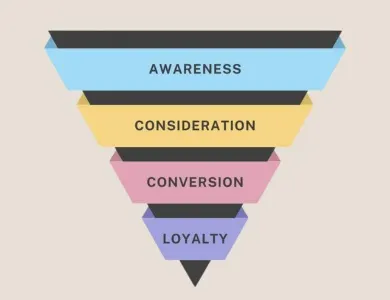
A sales funnel is a structured framework that describes the customer journey from discovering your brand to making a purchase. It’s called a “funnel” because it starts wide, capturing a large audience, and narrows as customers move closer to buying. The typical stages are:
- Awareness: Customers realize they have a problem or need and start searching for solutions.
- Interest: Customers gain a better understanding of your product or service and view it as a potential solution.
- Decision: Customers evaluate different options and make their decision on whether to purchase from you.
- Action: Customers make the purchase and become buyers.
Some models include additional stages, like Loyalty (repeat purchases) or Advocacy (recommending your brand). For this guide, we’ll focus on the core four stages but also touch on post-purchase engagement to ensure long-term success.
Why Is a Sales Funnel Important?
A sales funnel helps you:
- Understand where customers are in their buying journey.
- Deliver the appropriate message at the right time.
- Increase conversions by addressing customer needs at each stage of the buying process.
- Save time and resources by concentrating on high-potential leads.
The Power of SEO and Content Marketing
SEO and Content Marketing are the backbone of a high-converting sales funnel. Here’s how they work together:
- SEO: Optimizes your website and content to rank higher in search engine results, making it easier for potential customers to find you.
- Content Marketing: Creates valuable, relevant content—like blog posts, videos, or ebooks—that attracts and engages your audience. This content builds trust and guides customers through the funnel.
By integrating these strategies, you can ensure your funnel is both discoverable and persuasive.
Building Your Sales Funnel: A Step-by-Step Guide
Let’s dive into each stage of the sales funnel and explore how to use SEO and Content Marketing to optimize it, incorporating additional strategies to boost conversions.
Stage 1: Awareness (Top of the Funnel – ToFu)
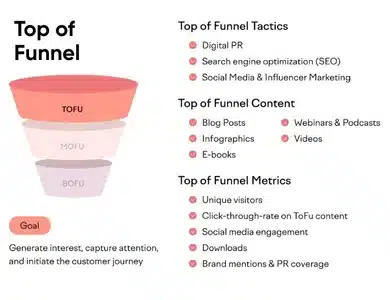
The Awareness stage is when potential customers first discover your brand. They are looking for solutions to a problem or need, but are not ready to make a purchase yet. Your goal during this stage is to increase your business’s visibility and offer value to capture their attention.
SEO Strategies for Awareness
- Keyword Research: Use tools like Answer the Public or Ubersuggest to identify broad, informational keywords.
- On-Page SEO: Optimize your blog posts, homepage, and other pages with these keywords. Include them in title tags, meta descriptions, headers, and body content.
- Query-Based Long-Tail Keywords: Find questions your audience is asking using platforms like Quora or Reddit.
- Local SEO: If you have a physical location, optimize for local searches by claiming your Google My Business listing and encouraging reviews.
Content Marketing for Awareness
- Blog Posts: Write engaging posts that address common pain points or questions.
- Videos: Make short, informative videos for platforms such as YouTube and Instagram Reels.
- Infographics: Design visually appealing infographics that simplify complex topics, Share them on social media and your website.
- Social Media: Be active on platforms like Instagram and Facebook. Share your content and interact with your followers to enhance brand awareness.
Creating Detailed Buyer Personas
To make your Awareness stage more effective, research your current customers to develop detailed buyer personas. These are profiles that outline your ideal customers’ demographics, challenges, goals, and behaviours.
Example
Imagine you run a fitness equipment store. You create a blog post titled “5 Signs You Need a Home Gym” optimized for keywords like “home workout benefits.” You share it on social media and create a YouTube video version, driving traffic to your site and introducing your brand to potential customers.
Stage 2: Interest (Middle of the Funnel – MoFu)
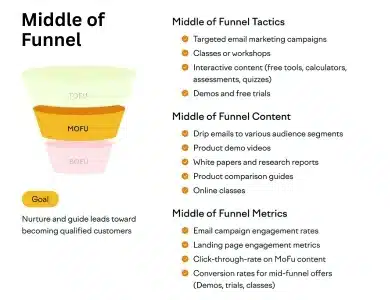
During the Interest stage, customers are aware of your brand and are eager to learn more. They research solutions and evaluate whether your product or service meets their needs. Your goal is to nurture this interest and build trust.
SEO Strategies for Interest
- Long-Tail Keywords: Target specific keywords that show research intent, like “best home gym equipment for weight loss” or “how to choose fitness equipment.”
- Content Hubs: Create pillar pages that cover a broad topic in-depth, linking to related blog posts.
- Internal Linking: Guide users from awareness content to interest content with internal links, helping them explore your site and move through the funnel.
- Guest Blogging: Contribute articles to authoritative sites to build your profile and drive traffic. For example, a guest post on “Top Home Workout Trends” on a fitness blog can link back to your site (Guest Blogging Benefits).
Content Marketing for Interest
- Ebooks: Offer free resources like “The Ultimate Guide to Home Fitness” to provide deeper insights. Require an email address to download, and build your email list.
- Case Studies: Share success stories.
- Thought Leadership Content: Create in-depth content like original research or expert guides to position your brand as an industry leader.
Personalization in Email Marketing
Use the email addresses collected from ebook downloads or webinar sign-ups to send personalized emails. Address recipients by name, reference their interests and tailor content to their funnel stage. Personalized emails can significantly boost engagement, including personalized discounts.
Example
For your fitness store, you offer a free ebook titled “The Beginner’s Guide to Home Fitness” promoted through your blog. You also host a webinar on “Creating a Home Workout Plan,” encouraging attendees to explore your products. A personalized email follow-up with workout tips helps keep leads engaged.
Stage 3: Decision (Bottom of the Funnel – BoFu)
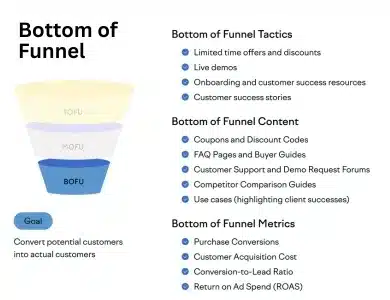
In the Decision stage, customers are ready to buy but need to choose between you and your competitors. You aim to provide persuasive information and reassurance to make your product a clear choice.
SEO Strategies for Decision
- Product Pages: Optimize product pages with keywords. Include detailed descriptions, images, and specifications.
- Reviews and Testimonials: Add customer reviews to product pages and use schema markup to display star ratings in search results.
- On-Site Search Data: Analyze what users search for on your site to create targeted content (Site Structure SEO).
Content Marketing for Decision
- Product Comparisons: Write articles comparing your products to competitors, highlighting your unique benefits.
- Testimonials and Case Studies: Feature detailed customer stories. Use video testimonials for greater impact.
- Free Trials or Demos: Offer a trial period or virtual demo to let customers experience your product.
- Webinars and Workshops: Organize live demonstrations through webinars and workshops to showcase products or skills.
Reputation Building ( Online Reputation Building Websites )

Enhance your brand’s reputation by encouraging employee and customer reviews on platforms like Google, LinkedIn, Twitter and eBay. Showcase endorsements and case studies on your website, and consider speaking at industry events or hosting webinars to establish authority. A strong reputation builds trust and influences purchase decisions (B2B Lead Generation).
Lead Scoring
Implement lead scoring to prioritize leads based on their level of engagement and likelihood of conversion. For example, a lead who downloads an ebook, attends a webinar, and visits product pages is more likely to buy than someone who only reads a blog post. Focus your efforts on high-scoring leads (Lead Scoring Guide).
Stage 4: Action
The Action stage is when customers complete their purchase. Your goal is to make the buying process seamless and encourage repeat business.
SEO Strategies for Action
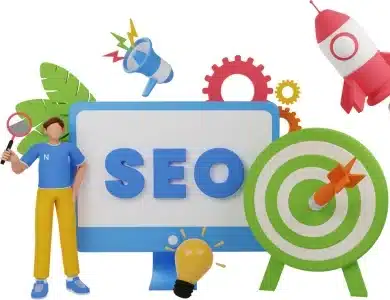
- Landing Pages: Optimize landing pages with clear CTAS and keywords. Make sure to achieve fast loading times by utilizing tools such as Google PageSpeed Insights.
- Site Speed: A slow website can lead to cart abandonment, so prioritize speed optimization (On-Page SEO).
- Mobile Optimization: Ensure your site is mobile-friendly, as many customers shop on their phones.
Content Marketing for Action
- Clear CTAS: Use compelling CTAS like “Buy Now” or “Start Your Journey Today.”
- Simplified Checkout: Streamline the process with minimal steps and guest checkout options.
- Retargeting: Use retargeting ads on platforms like Facebook to re-engage visitors who abandoned their carts (Lead Conversion Strategies).
- Post-Purchase Content: Send welcome emails with setup guides or workout tips. Offer loyalty programs to encourage repeat purchases.
Example
Your store’s landing page has a “Buy Now” button and a simple checkout process. If a customer abandons their cart, you run retargeting ads highlighting a discount. After purchase, you will be sent a welcome email with a free workout plan.
Importance of Defining Your Target Audience
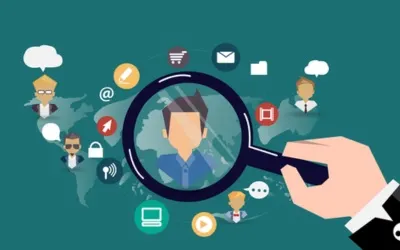
Focusing on a specific audience prevents wasted resources on irrelevant groups, with research indicating that up to $37 billion is lost annually on ineffective ads (Marketing Evolution). By tailoring your offerings to your audience’s needs, you enhance engagement and loyalty. For instance, 80% of consumers prefer personalized experiences, which can significantly increase business success (Adweek).
Statistical Insights
- Personalization Impact: 89% of marketing leaders see personalization as critical for future success, yet only 60% of customers feel companies deliver it, highlighting a gap in audience understanding (Contentful).
- Conversion Rates: Hyper-personalized campaigns can increase conversion rates by up to 60%, making audience definition a key driver of profitability (Trask).
- Consumer Expectations: 91% of consumers are more likely to shop with brands offering personalized recommendations, emphasizing the need for precise targeting (Wunderkind).
Steps to Define Your Target Audience and Their Needs
The process involves structured steps to create a clear picture of your audience and align your marketing with their expectations. Below is a detailed guide with examples and tools.
1. Analyze Your Current Customer Base
Examine existing customers to understand their demographics (age, gender, income), interests, and behaviors. Use surveys, interviews, or social media analytics to gather insights. For example, a fitness app might survey users to identify their workout goals, revealing patterns like a preference for morning routines among young professionals.
2. Conduct Market Research
Explore industry trends and competitor strategies to identify opportunities. Tools like Ahrefs or Google Analytics can analyze website traffic and keywords. For instance, noticing a trend toward eco-friendly products could guide a business to target environmentally conscious consumers.
3. Segment Your Market
Divide your market into groups based on:
- Demographics: Age, gender, income, education.
- Psychographics: Values, interests, lifestyle.
- Behaviors: Purchase habits, brand loyalty. A running shoe brand might segment into beginners needing comfort and pros seeking performance, tailoring products accordingly (Sprout Social).
4. Create Buyer Personas
Develop detailed profiles of your ideal customers, often called buyer personas, based on the data collected.
Include specifics like age, profession, education, income, marital status, goals, pain points, media consumption, hobbies, and habits.
5. Understand Their Needs
Identify problems your audience faces and how your product solves them. Busy professionals might need quick meal solutions like HelloFresh, while students seek affordable options. Use focus groups or social listening to align offerings with expectations.
6. Define Non-Target Audiences
Specify who isn’t your audience to avoid wasted efforts. For a women’s fitness app, exclude men or older demographics to focus ad spend (Marketing Evolution).
7. Choose Marketing Channels
Select platforms where your audience is active, like Instagram for youngsters or LinkedIn for professionals. Tailor content to each channel’s style (Sprout Social).
8. Test and Refine
Continuously validate your audience through feedback and analytics. Adjust strategies based on new insights, such as a shift toward sustainable products, to stay relevant (Google Analytics).
Post-Purchase: Loyalty and Advocacy
While not a core stage, post-purchase engagement is key to turning customers into repeat buyers and brand advocates.
- Loyalty Programs: Offer discounts or rewards for repeat purchases.
- Community Engagement: Invite customers to join a community, like a fitness group on social media.
- Thank-You Content: Send thank-you emails or videos to show appreciation.
- Customer Onboarding and Support: Provide comprehensive documentation, tutorials, and dedicated support to ensure customers get the most out of their purchase. For example, a setup guide for fitness equipment or a live chat for troubleshooting can reduce churn (Customer Retention).
Technical SEO is also essential:
- Site Speed: Optimize with tools like Google PageSpeed Insights.
- Mobile-Friendliness: Use responsive design for all devices.
- Security: Install an SSL certificate for trust and rankings (Internal Linking).
Measuring and Optimizing Your Funnel
To ensure your funnel performs well, track key metrics and make data-driven improvements.
Key Metrics
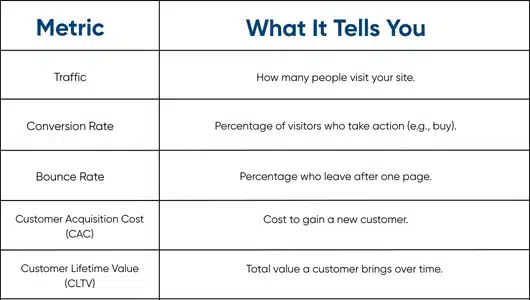
Tools for Optimization
- Google Analytics: Tracks traffic and conversions.
- Hotjar: Analyzes user behavior with heatmaps.
- A/B Testing Tools: Tests page variations with platforms like Optimizely or VWO.
Continuous Optimization with Data
Use analytics to identify drop-off points in your funnel. For example, if many visitors leave at the checkout stage, test a simpler checkout process. Conduct A/B tests on headlines, CTAs, or layouts to find what works best. Regularly update content to stay relevant and address customer objections through FAQs or support (Conversion Optimization).
Conclusion
Building a high-converting sales funnel with SEO and Content Marketing is a powerful way to grow your business. By optimizing each stage—Awareness, Interest, Decision, and Action—and incorporating strategies like buyer personas, thought leadership, and lead scoring, you can attract the right audience, build trust, and drive purchases. Continuous optimization with data ensures your funnel stays effective over time.
Start by researching your audience and creating valuable content tailored to their needs. Use SEO to make that content discoverable, and track your results to refine your approach. With persistence, you’ll create a sales funnel that drives consistent revenue and turns visitors into loyal customers.



Add a Comment